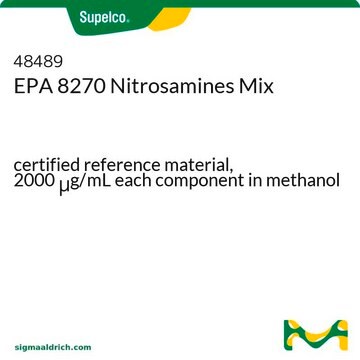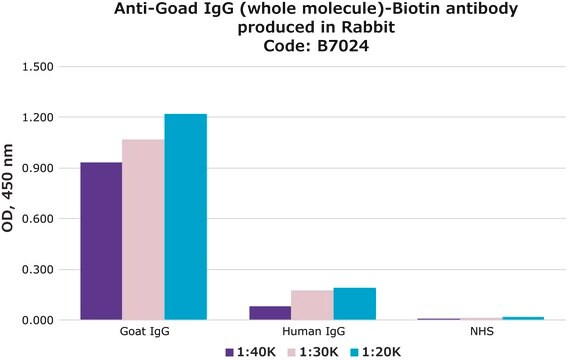B8061
N-Butyl-N-(4-hydroxybutyl)nitrosamine
ISOPAC®, ≥90% (GC)
Sinonimo/i:
BBN, N-Butyl-N-butan-4-ol-nitrosamine, N-Butyl-N-nitroso-4-aminobutanol
Autenticatiper visualizzare i prezzi riservati alla tua organizzazione & contrattuali
About This Item
Formula empirica (notazione di Hill):
C8H18N2O2
Numero CAS:
Peso molecolare:
174.24
Codice UNSPSC:
12352116
NACRES:
NA.25
Prodotti consigliati
Livello qualitativo
Saggio
≥90% (GC)
Stato
liquid
Temperatura di conservazione
2-8°C
InChI
1S/C8H18N2O2/c1-2-3-6-10(9-12)7-4-5-8-11/h11H,2-8H2,1H3
DIKPQFXYECAYPC-UHFFFAOYSA-N
Applicazioni
N-Butyl-N-(4-hydroxybutyl)nitrosamine (BBN), a carcinogen, is used to induce histiologically relevant aggressive urinary bladder cancer in animal models.
Azioni biochim/fisiol
Carcinogen used to induce urinary bladder cancer in animal models. The result of exposure is histologically comparable to human urinary bladder tumorigenesis. Used in chemopreventative studies.
Confezionamento
Packaged in a 100 mL serum bottle with butyl rubber stopper and aluminum tear seal.
Avvertenza
Injecting any compatible solvent permits preparation of any desired strength solution without exposure.
Ricostituzione
Dissolving the contents in 100 mL of solvent yields a 1% solution.
Note legali
Isopac is a registered trademark of Merck KGaA, Darmstadt, Germany
Avvertenze
Danger
Indicazioni di pericolo
Consigli di prudenza
Classi di pericolo
Acute Tox. 4 Oral - Carc. 1B
Codice della classe di stoccaggio
6.1C - Combustible acute toxic Cat.3 / toxic compounds or compounds which causing chronic effects
Classe di pericolosità dell'acqua (WGK)
WGK 3
Punto d’infiammabilità (°F)
296.6 °F
Punto d’infiammabilità (°C)
147 °C
Dispositivi di protezione individuale
Eyeshields, Faceshields, Gloves, type ABEK (EN14387) respirator filter
Scegli una delle versioni più recenti:
Possiedi già questo prodotto?
I documenti relativi ai prodotti acquistati recentemente sono disponibili nell’Archivio dei documenti.
I clienti hanno visto anche
Vernon E Steele et al.
Cancer prevention research (Philadelphia, Pa.), 2(11), 951-956 (2009-11-07)
Nonsteroidal anti-inflammatory drugs (NSAID) have been highly effective in preventing colon, urinary bladder, and skin cancer preclinically, and also in clinical trials of colon adenoma formation. However, certain NSAIDs cause gastrointestinal ulceration and may increase cardiovascular events. Naproxen seems to
Inhibition of bladder tumor growth by chitooligosaccharides in an experimental carcinogenesis model.
João C Fernandes et al.
Marine drugs, 10(12), 2661-2675 (2013-01-25)
Urinary bladder cancer is one of the most common cancers worldwide, with the highest incidence in industrialized countries. Patients with cancer commonly use unconventional and complementary therapy including nutraceuticals. In this study we evaluated the efficacy of chitooligosaccharides (in orange
Yuji Sagara et al.
Cancer epidemiology, 34(3), 350-354 (2010-04-07)
Green tea polyphenol (GTP) suppresses malignancy in bladder cancer cell lines. However, the detail of its anti-carcinogenic effect in vivo is not fully understood. This study investigated the effect of GTP on bladder tumor size and angiogenesis in mice given
Nelci Antunes de Moura et al.
Archives of toxicology, 84(2), 165-173 (2009-11-11)
The potential promoting effect of Diuron was investigated in a mouse model of mammary and urinary bladder carcinogenesis induced by 7,12-dimethylbenz(a)anthracene (DMBA) and N-butyl-N-(4-hydroxybutyl)nitrosamine (BBN). Four-week old female Swiss mice were allocated to five groups: Groups G1-G3 received DMBA (5
Ting-Tsz Ou et al.
Journal of ethnopharmacology, 135(1), 162-172 (2011-03-15)
Extracts of Paeonia lactiflora Pall (RPA), a traditional Chinese medicines has been shown to treat cancers. The purpose of this study is to evaluate the anticancer effect of RPA in urinary bladder carcinoma in vitro and in vivo. The cell
Il team dei nostri ricercatori vanta grande esperienza in tutte le aree della ricerca quali Life Science, scienza dei materiali, sintesi chimica, cromatografia, discipline analitiche, ecc..
Contatta l'Assistenza Tecnica.











![9-Borabicyclo[3.3.1]nonane solution 0.5 M in THF](/deepweb/assets/sigmaaldrich/product/structures/180/891/8b64e597-269d-4780-98b6-40889dfd06b9/640/8b64e597-269d-4780-98b6-40889dfd06b9.png)
